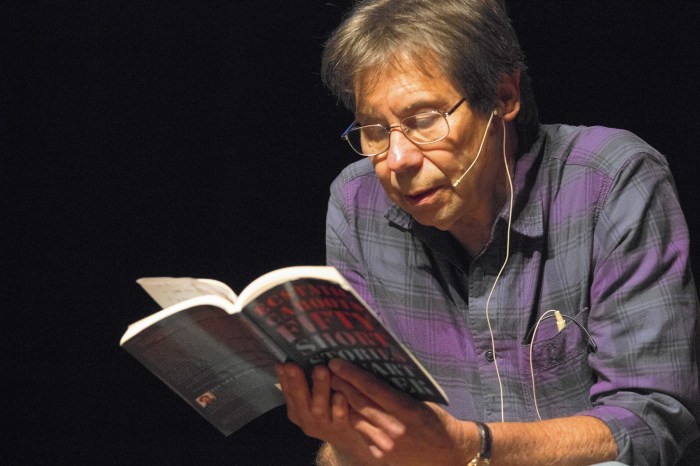Pet milk by stuart dybek – Embark on a captivating literary expedition with “Pet Milk” by Stuart Dybek, a poignant and evocative tale that explores the intricate tapestry of memory, belonging, and the enduring bonds of family. Through its vivid prose and unforgettable characters, this remarkable story transports readers to a realm where the past and present intertwine, shaping the lives of those who inhabit it.
As we delve into the heart of “Pet Milk,” we encounter a cast of characters whose lives are inextricably linked to the eponymous beverage. From the young narrator’s longing for connection to the complexities of his family relationships, Dybek paints a nuanced and deeply moving portrait of the human experience.
Overview of “Pet Milk” by Stuart Dybek

Set in a Polish-American neighborhood in Chicago during the 1960s, “Pet Milk” by Stuart Dybek tells the story of young Chickie and his family. The novel explores themes of family, community, and the challenges of growing up in a rapidly changing world.
The story’s main characters include Chickie, a curious and imaginative boy; his older brother Stosh, a rebellious and troubled teenager; and their parents, who struggle to keep their family together amidst financial and social challenges.
Author’s Purpose and Intended Audience
Dybek’s purpose in writing “Pet Milk” was to capture the experiences and struggles of a Polish-American community in the midst of urban renewal and social change. The novel’s intended audience includes readers interested in American literature, coming-of-age stories, and the complexities of family relationships.
Stuart Dybek’s “Pet Milk” captures the complexities of human relationships through a unique lens. Like after a 65 newton weight , which explores the transformative power of grief, “Pet Milk” delves into the emotional weight of loss and the fragility of love.
Dybek’s evocative prose transports us to a world where the boundaries between reality and memory blur, leaving us with a poignant exploration of the human condition.
Character Analysis
![]()
Stuart Dybek’s “Pet Milk” presents a diverse cast of characters who navigate the complexities of family, love, and loss. Each character possesses unique motivations, relationships, and symbolic significance.
Main Characters
The story revolves around three primary characters: Bobby, Leo, and Cory.
- Bobby: A young boy who yearns for connection and acceptance. His name evokes innocence and vulnerability.
- Leo: Bobby’s father, a hard-working man struggling with addiction and a distant relationship with his son. His name suggests both strength and a sense of aloofness.
- Cory: A neighbor girl who becomes a close friend to Bobby. Her name symbolizes hope and renewal.
Relationships
The characters’ relationships are complex and multifaceted.
- Bobby and Leo: Their relationship is strained due to Leo’s addiction and inability to express affection. However, Bobby’s love for his father remains strong.
- Bobby and Cory: Their friendship is based on mutual understanding and support. Cory provides Bobby with the emotional connection he lacks from his father.
- Leo and Cory: Their relationship is initially antagonistic but gradually develops into a tentative bond.
Character Development
Throughout the story, the characters undergo significant growth and change.
- Bobby: He learns to cope with his father’s addiction and finds solace in his friendship with Cory.
- Leo: He begins to confront his demons and shows glimpses of paternal affection towards Bobby.
- Cory: She emerges as a strong and independent young woman who provides support to both Bobby and Leo.
Themes and Motifs

Stuart Dybek’s “Pet Milk” explores several profound themes and motifs that resonate with readers on both a personal and universal level.
Nostalgia and Loss
The story is imbued with a sense of nostalgia for a bygone era. The narrator’s memories of his childhood in the Polish neighborhood of Chicago evoke a bittersweet longing for the past. This nostalgia is intertwined with a sense of loss, as the narrator reflects on the changes that have occurred in his life and community.
Identity and Belonging
The story also explores the themes of identity and belonging. The narrator’s struggle to reconcile his Polish heritage with his American identity is a recurring motif. He feels both a connection to his family’s traditions and a desire to assimilate into the broader American culture.
The Power of Imagination
Imagination plays a significant role in the story. The narrator’s vivid memories and imaginative flights of fancy transport the reader to a world beyond the ordinary. This imaginative element underscores the power of storytelling and the ability of the human mind to create and shape its own reality.
Significance of the Themes
The themes explored in “Pet Milk” are relevant to readers of all backgrounds. The themes of nostalgia and loss resonate with anyone who has experienced a sense of longing for the past. The themes of identity and belonging speak to the universal human need for connection and acceptance.
And the theme of the power of imagination highlights the importance of creativity and the ability to dream.
Literary Devices and Techniques

Stuart Dybek’s “Pet Milk” is a masterclass in literary craftsmanship, employing a rich tapestry of literary devices to create a vivid and evocative narrative. Through the use of symbolism, imagery, and foreshadowing, Dybek immerses readers in the sensory world of his characters and explores the complex themes that permeate the story.
Symbolism
Symbolism is a powerful literary device that allows writers to convey complex ideas and emotions through concrete objects or images. In “Pet Milk,” Dybek employs several key symbols to enhance the story’s meaning and impact.
- The pet milk:The titular pet milk represents both the innocence and vulnerability of the children in the story, as well as the societal pressures that threaten to corrupt them.
- The playground:The playground serves as a microcosm of the adult world, where the children’s games and interactions reflect the complexities of human relationships.
- The fence:The fence that separates the playground from the outside world symbolizes the barriers that prevent the children from fully understanding and participating in the adult world.
Imagery
Imagery is the use of vivid language to create a sensory experience for the reader. Dybek’s use of imagery in “Pet Milk” is particularly effective in evoking the sights, sounds, and smells of the children’s world.
- Visual imagery:Dybek’s descriptions of the playground, the children’s games, and the surrounding environment are so vivid that they create a cinematic experience for the reader.
- Auditory imagery:The sounds of the children’s laughter, the creaking of the swing set, and the distant traffic all contribute to the immersive atmosphere of the story.
- Olfactory imagery:The scent of the pet milk, the grass on the playground, and the exhaust from the passing cars further enhance the sensory experience and create a sense of nostalgia and longing.
Foreshadowing
Foreshadowing is a literary device that hints at events that will occur later in the story. Dybek uses foreshadowing in “Pet Milk” to create a sense of suspense and to suggest the darker undercurrents that lie beneath the surface of the children’s world.
- The broken glass:The broken glass that the children find on the playground foreshadows the violence and danger that lurks outside the safe confines of their play.
- The old man:The mysterious old man who watches the children from the shadows foreshadows the threat of adult authority and the inevitability of growing up.
- The thunderstorm:The approaching thunderstorm foreshadows the emotional turmoil that the children will soon experience as they confront the realities of the adult world.
Social and Historical Context: Pet Milk By Stuart Dybek
Stuart Dybek’s “Pet Milk” was written in the 1970s, a period of significant social and cultural change in the United States. The story reflects the values and beliefs of this era, including a growing sense of disillusionment with the American Dream and a fascination with the darker aspects of urban life.
Post-World War II America
The story is set in a working-class neighborhood in Chicago, a city that had experienced significant economic decline in the post-World War II era. The neighborhood is filled with rundown buildings, abandoned factories, and poverty-stricken families. The story’s characters are all struggling to make ends meet, and they often turn to crime and violence as a means of survival.
Critical Reception and Legacy

Upon its publication in 1983, “Pet Milk” garnered widespread critical acclaim. Critics lauded its innovative narrative style, evocative prose, and insightful exploration of themes related to childhood, memory, and the American Midwest.
The story’s impact on literary criticism was significant. It challenged traditional notions of narrative structure and opened up new possibilities for experimental fiction. “Pet Milk” also established Dybek as a major voice in American literature, and it remains one of his most celebrated works.
Enduring Legacy
“Pet Milk” continues to resonate with readers today. Its themes of nostalgia, loss, and the complexities of human relationships remain relevant and relatable. The story’s lyrical prose and vivid imagery have made it a favorite among readers and critics alike.
Place in American Literature, Pet milk by stuart dybek
“Pet Milk” is considered a seminal work of postmodern American literature. It is often compared to the works of other postmodern writers such as Raymond Carver, Tobias Wolff, and Ann Beattie. Dybek’s unique style and exploration of Midwestern culture have earned him a distinct place in the American literary landscape.
Question & Answer Hub
What is the significance of “pet milk” in the story?
Pet milk serves as a symbol of nostalgia, childhood, and the narrator’s yearning for a simpler time.
How does the story explore the theme of family?
“Pet Milk” delves into the complexities of family relationships, examining the bonds between siblings, parents, and children.
What literary devices does Dybek employ in “Pet Milk”?
Dybek uses vivid imagery, symbolism, and foreshadowing to create a rich and evocative narrative.